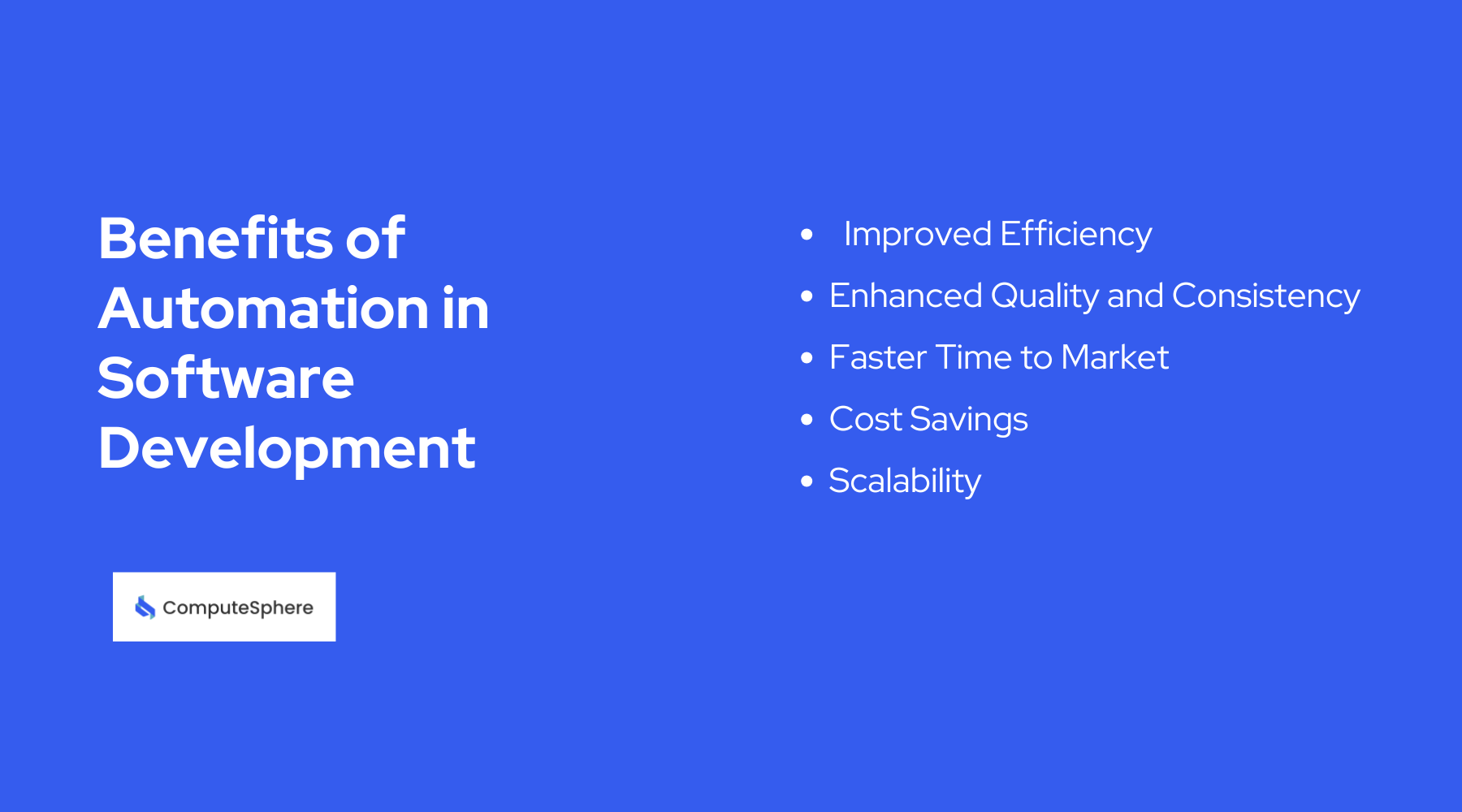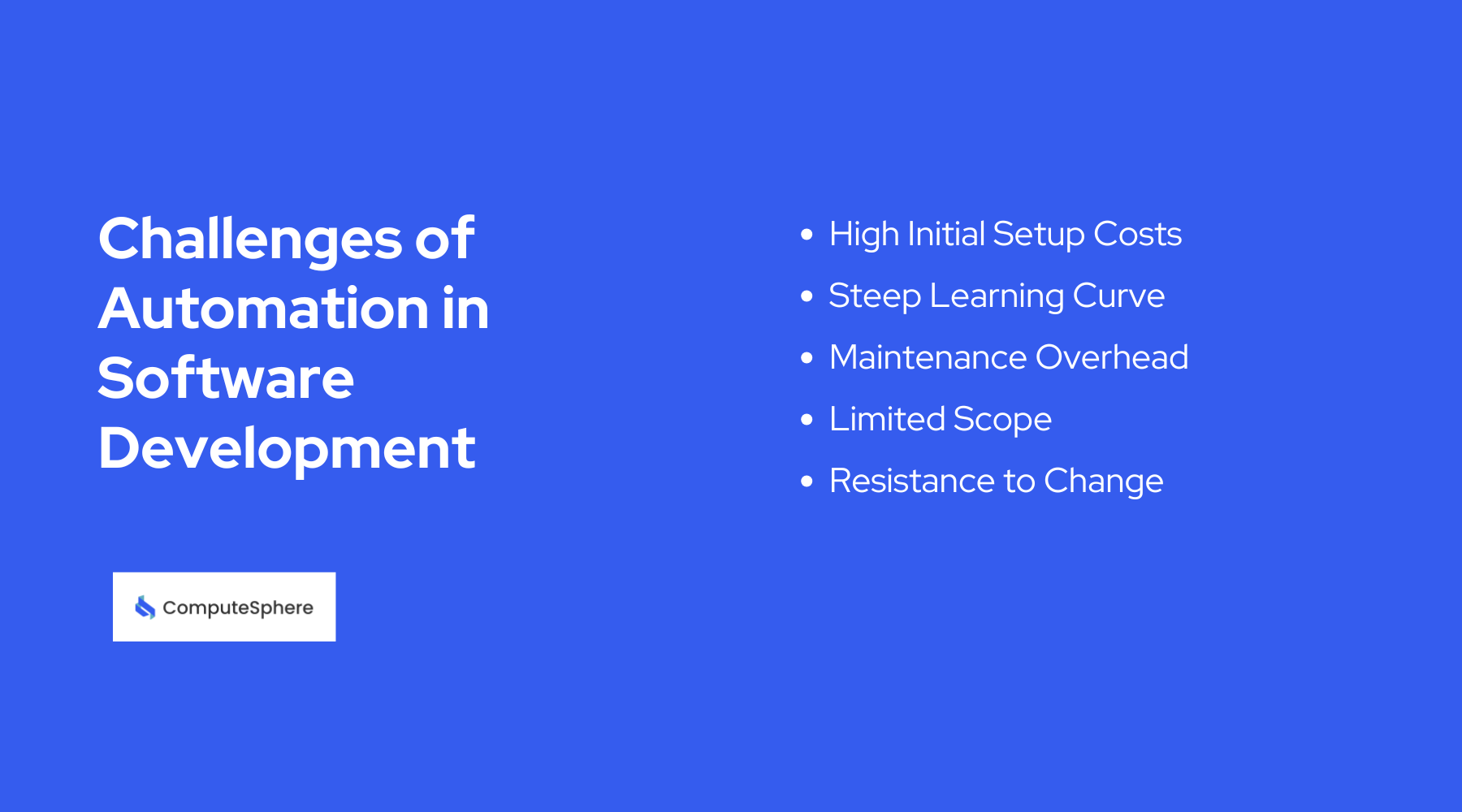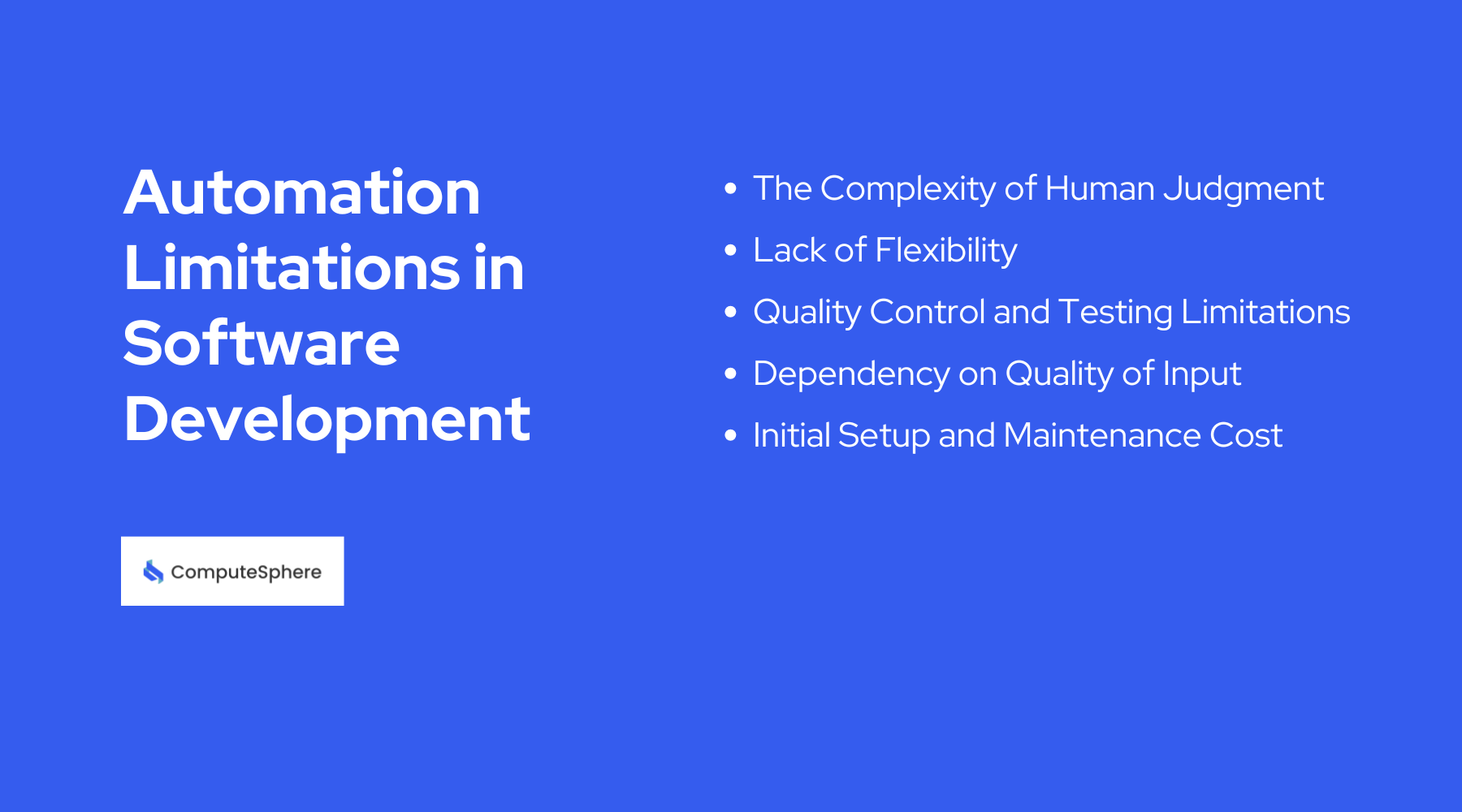Automation in Software Development: Benefits, Challenges and Limitations

The global software automation market, valued at $6.6 billion in 2021, is projected to grow at a 16.2% CAGR, reaching $18.6 billion by 2030. Automation in software development accelerates delivery, enhances reliability, and reduces errors by handling repetitive tasks like testing and deployment. It frees developers to focus on innovation and solving complex challenges, driving higher-quality, impactful software. Moreover, automation builds scalability. It allows businesses to handle growing demands efficiently. In short, it is a catalyst for creating smarter, faster, and more reliable software.
In this guide, we’ll cover the importance of automation in software development, explore its benefits, and share valuable tips for optimizing your processes.
What Is Automation in Software Development?
Automation in software development refers to the process of using tools, scripts, and frameworks to execute repetitive tasks with minimal or no human intervention. These tasks can range from coding and testing to deployment and maintenance.
In traditional workflows, many tasks require manual effort, which can be error-prone and time-consuming. Automation addresses this by creating predefined scripts or using advanced tools that perform these tasks systematically and accurately. This ensures that software development processes are consistent and scalable, regardless of the project size.
For example, consider Continuous Integration and Continuous Deployment (CI/CD) pipelines. Automation in these pipelines ensures that whenever new code is added to the repository, it is automatically tested, integrated, and deployed without requiring manual input at each stage. This speeds up the development process and reduces the chances of human error.
What Can You Automate in a Software Development Process?

Automation in software development is not limited to a single phase; it spans multiple stages of the software development lifecycle. Here are some key areas where automation plays a crucial role:
1. Code Generation
Rewriting repetitive code over and over can feel like a drain on creativity. Automation tools like JHipster andYeomantake the monotony out of coding by generating templates and frameworks for your application. This not only saves time but also ensures consistency across your codebase.
2. Testing
Testing is a basis of quality assurance, but doing it manually can be time-consuming and error-prone. Automated testing tools such as Seleniumand JUnitallow developers to create scripts that run tests at scale. Whether it's unit tests or complex integration tests, automation ensures your software works as intended without wasting hours of manual effort.
3. Build Automation
Compiling and packaging software manually can lead to mistakes and wasted time. Tools like Maven and Gradle automate this process, ensuring every build is consistent and reliable. With automated builds, teams can focus on creating great code, not just compiling it.
4. Deployment
Deploying software manually to production or staging environments can be risky and time-consuming. Tools likeJenkins, Docker, and Kubernetes make deployment smooth and reliable. They ensure that your software gets where it needs to be—quickly and without errors.
5. Monitoring and Maintenance
Once your software is live, keeping it running smoothly can feel like a constant battle. Automated monitoring tools like Prometheus andNagios keep an eye on performance, sending alerts the moment something goes wrong. These tools allow you to fix issues proactively, keeping users happy and systems stable.
What Are the Benefits of Automation in Software Development?

The advantages of automation in software development are multifaceted, affecting both productivity and quality. Let’s explore these benefits in detail:
1. Improved Efficiency
Automation eliminates repetitive and time-intensive tasks, such as running tests or compiling code, allowing developers to focus on creative problem-solving and innovation. It’s like delegating routine chores to a dependable assistant, freeing your team to work smarter, not harder.
2. Enhanced Quality and Consistency
Automation ensures tasks are executed flawlessly and uniformly every time, minimizing errors and maintaining a high standard of quality. It’s comparable to a master craftsman replicating their finest work consistently, guaranteeing reliable results across every project.
3. Faster Time to Market
Development cycles speed up by automating key processes like testing, building, and deployment. This allows your team to quickly adapt to market needs, releasing updates and features faster while maintaining top-notch quality.
4. Cost Saving
Although automation tools require an upfront investment, they deliver significant long-term savings. With fewer bugs, streamlined workflows, and reduced manual labor, your team can focus on value-driven tasks, saving both time and resources.
5. Scalability
As your projects grow in complexity, automation scales effortlessly to meet demands. Whether it’s running thousands of tests or deploying across multiple platforms, automation adapts to your needs, ensuring your team remains productive without being overburdened.
Challenges of Automation in Software Development

Despite its advantages, automation is not without challenges. Development teams often encounter obstacles that disrupt seamless implementation. Here are some common challenges:
1. High Initial Setup Costs
Getting started with automation can feel like a big investment. From purchasing tools to setting up workflows, the upfront time and cost can seem daunting, especially for smaller teams. However, it's important to see this as a long-term investment in efficiency and quality.
2. Steep Learning Curve
Adopting new automation tools requires training and practice. Team members may feel overwhelmed as they try to integrate these tools into their workflows. The key is to provide consistent training and focus on gradual adoption, so no one feels left behind.
3. Maintenance Overhead
Automation isn’t a “set it and forget it” process. Scripts and tools require regular updates to keep up with changes in the codebase or technology. Neglecting maintenance can lead to automation failures, making it more of a burden than a benefit.
4. Limited Scope
Not every task can or should be automated. Creative tasks, exploratory testing, or processes requiring human judgment often fall outside the scope of automation. Striking the right balance between automation and manual effort is crucial to avoid inefficiencies.
5. Resistance to Change
Introducing automation can sometimes meet resistance from team members who are comfortable with existing workflows. They may worry about job security or struggle to adapt. Open communication and highlighting the benefits can help ease these concerns.
Tips to Overcome the Challenges

Successfully overcoming the challenges of automation in software development requires a balanced approach. Here are some actionable tips:
1. Start Small and Build Gradually
Don’t try to automate everything at once—it can be overwhelming. Begin with simple, repetitive tasks like unit testing or builds to show quick wins. This approach builds confidence and allows the team to grow their skills and adapt at a manageable pace.
2. Choose the Right Tools
Not all tools will suit your team’s needs or project requirements. Take the time to research and test tools that align with your goals and integrate seamlessly into your workflow. The right tools can make automation feel like a natural extension of your process rather than a disruption.
3. Provide Adequate Training
Automation tools often come with a learning curve, so invest in training your team. Host workshops, share resources, or pair less experienced team members with automation-savvy colleagues. Empowering your team with knowledge reduces resistance and fosters collaboration.
4. Regularly Maintain Automation Systems
Automation is not a “set-it-and-forget-it” solution. Assign a team or individual to keep automation scripts and tools up to date. Regular reviews and maintenance ensure the system evolves with your project and avoids becoming a bottleneck.
5. Encourage a Growth Mindset
Change can be uncomfortable, especially for teams used to manual workflows. Foster a culture of curiosity and openness by highlighting how automation improves efficiency and job satisfaction. Emphasize that it’s a tool to make their work easier, not replace them.
Automation Limitations in Software Development

1. Complexity of Human Judgment
Automation excels at repetitive, rule-based tasks but struggles with decisions that require human intuition, creativity, and complex judgment. Tasks like making design decisions, choosing appropriate architecture, or addressing unforeseen edge cases often involve deep understanding that go beyond predefined rules. Humans can balance trade-offs, incorporate subjective factors, and adapt to unique circumstances, whereas automation lacks the flexibility to apply these insights effectively.
2. Lack of Flexibility
Automated systems are typically optimized for specific workflows, environments, or predefined tasks. When project requirements shift or unexpected challenges arise, these systems may become rigid, and unable to adjust quickly or appropriately. Unlike humans, who can reframe problems, pivot strategies, and find creative solutions, automated systems may require significant reconfiguration or even manual intervention to handle novel situations effectively.
3. Quality Control and Testing Limitations
While automation can accelerate testing processes, it has limitations in identifying subtle, context-sensitive bugs or usability issues. Automated tests are only as thorough as they are designed to be, often missing issues that arise from real-world usage patterns or unanticipated user behavior. Exploratory testing, conducted by skilled human testers, is invaluable for uncovering edge-case scenarios and issues that automated tests cannot foresee, especially in dynamic environments.
4. Dependency on Quality of Input
The effectiveness of any automated system is directly tied to the quality of the input it receives. Incomplete, incorrect, or ambiguous data can lead to incorrect outcomes, resulting in wasted effort and the need for significant rework. Automation requires clear, precise requirements and well-structured inputs to deliver accurate results. If these inputs are flawed or not aligned with the desired outcomes, automation tools can only replicate those mistakes at scale.
5. Initial Setup and Maintenance Cost
While automation offers long-term benefits in terms of speed and consistency, its implementation often comes with significant upfront costs. These costs include not only financial investment but also time and effort for proper setup and integration. Additionally, automated systems require ongoing maintenance, updates, and fine-tuning to stay effective. As technology evolves, automation tools may become outdated, necessitating further investment in resources and expertise to keep the system running efficiently.
Wrap-Up
Automation in software development is a transformative approach that drives efficiency, consistency, and scalability. By automating repetitive tasks, teams can focus on innovation and deliver higher-quality products faster, all while saving costs in the long run.
However, it’s important to remember that implementing automation isn’t without its hurdles. Challenges like choosing the right tools, addressing skill gaps, and managing initial setup efforts require thoughtful planning. That said, with the right strategy, automation can seamlessly integrate into your processes, enabling your team to work smarter, not harder. Ultimately, embracing automation wisely will empower your team to meet the ever-growing demands of modern software development with confidence and efficiency.
Contents
Built for Builders. Priced for Startups.
Tired of unpredictable cloud bills? ComputeSphere offers modular, fixed-cost cloud hosting that grows with your startup—no DevOps headaches, no surprises.
Get StartedShare this article
Browse Some Related Blogs
Relevant and related contents you can read









